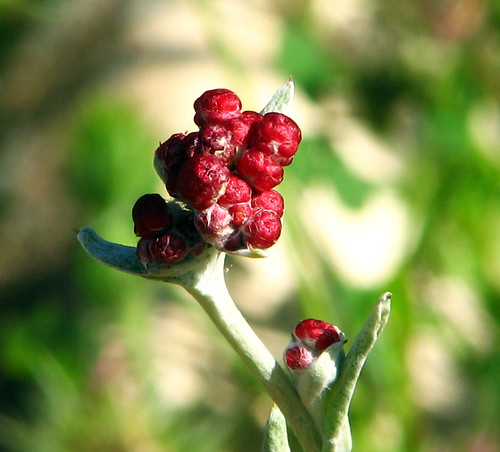Dam Hamacabbim = Helichrysum Sanguineum = Red Everlasting
One thing I should have done when I packed my luggage 8 years ago to moved to Vancouver was to my botanist’s bible, the guide (or definer) of Mediterranen plants. Yes, that strange thick book that helps you to find the Latin name and common name for every plant you see. I never thought I would even need to use one here, because there are no Mediterranen plants growing here. Innocently, I thought to myself that the West Coast Plant Guide will be sufficient to keep me connected to the Plant Kingdom, so I can call each flower its name when the time comes to communicate with them...
Alas, I was so wrong. I should have known better, and take the Mediterranean book with me. But how could I have possibly know that I would ever need to use it, even if just for the sake of finding out which aromatic plants grew in my country, or just to remember a name of a flower for an obscure article I will have on something called “blog” 8 years from than? The answer is, I wouldn’t have possibly be able to know. And so, I am very thankful that at least I kept the book in the safe hands of people that would use it and would be able to answer my question when I am just about to publish a ground breaking article in my blog, about a tiny flower that looks like droplets of blood. Sometimes Google just don't cut it. At least not when it comes to matching the folklor names of certain Jewish flowers with their Latin names.
So thanks to my mother and my grandmother (who shared between them the task of looking up the flower, and than emailing me the information), I now know that the little modest though strikingly beautiful flower, that is commonly known as “Dam Hamacabbim” (which literally means “Maccabees’ Blood”, allegedly grown out of the drops of blood that the Maccabees lost in their battles with the Helenist invaders sometime around 165 BC, rescued the temple and found the little can of oil, and to whom all Jews should be thankful if they like latkes and sufganiot/donuts). It is apparently a type of immortelle – from the same family of the immortelle we use in perfumery. Only that this red everlasting flower has non scent that I can recall, and even if it had any, it would be impossible to obtain it from the very scarce plants that appropriately bloom every year around Chanukka.
On another note, there is another type of everlasting flower in Israel, though I think it’s from a different family altogether – it’s purple, and looks like it’s made of paper, and grows on the beach. It is very often used in floral bouquets – everywhere in the world, I suspect – as it takes ages for the flowers to fade. They look dry even when they are fresh. If you know the name of this flower, let me know.





